Earn Up To 105 PDUs
Lean Six Sigma Certification
No Risk Money Back Guarantee | PDU's | Monthly Payment Plans | Lifetime Access
Choose Your Lean Six Sigma Certification Package for PDUs and Career Advancement.
50 PDUs
Lean Six Sigma
Yellow Belt Certification
Online Training & Certification

Lean Six Sigma Yellow Belt Certification - Course Details
| Course Title | Lessons | Quizzes |
Phase Tests |
Exam Attempts |
Exam Questions |
Pass Score |
Time Limit |
Pass Rate |
Sat. Rating | PDU |
Earned Designation |
Avg. Completion | Price |
|---|---|---|---|---|---|---|---|---|---|---|---|---|---|
| Lean Six Sigma Yellow Belt | 11 | 11 | 3 | 2 | 50 | 80% | 1Hr. | 97.9% | 96.4% | 50 | LSSYB | 27 Days | $595 |

Certification Requirements
- Complete all Lessons and Quizzes
- Pass all Phase Tests (unlimited attempts, passing score 80%)
- Pass the LSSYB Certification Exam (2 attempts, passing score 80%, 1hr. time limit)
- Complete the Required Course Feedback Form
Course Does Not Require a Project | Statistical Software is Not Required | Default Statistical References: Minitab. SigmaXL and JMP Versions are Available on Request | Curriculum Compatibility: Minitab v.22, SigmaXL v.10, JMP v.18. KEY: LSS = Lean Six Sigma | SS = Six Sigma | BB = Black Belt | GB = Green Belt | YB = Yellow Belt | PDU = Professional Development Units
Lean Six Sigma Yellow Belt Course Outline
-
Define Phase
Overview of Six Sigma
Six Sigma Fundamentals
Lean Six Sigma Projects
Lean Fundamentals
Define Phase Test
-
Measure Phase
Process Definition
Six Sigma Statistics
Measurement Systems
Process Capability
Measure Phase Test
-
Analyze PhasePatterns of Variation
Inferential Statistics
Hypothesis Testing
Hyp. Tests Normal
Hyp. Tests Non-Normal
Analyze Phase Test
-
Improve PhaseSimple Linear Regression
Multiple Regression
Design of Experiment
Full Factorial DOE
Fractional Factorial DOE
Improve Phase Test
-
Control Phase
Statistical Process Control
Six Sigma Control Plans
Lean Controls
Control Phase Test
LSSYB Certification Exam
-
DEFINE PHASE
-
Overview of Six Sigma
What is Six Sigma
Six Sigma History
Six Sigma Approach Y = f(x)
Six Sigma Methodology
Roles & Responsibilities -
Six Sigma Fundamentals
Defining a Process
VOC & CTQ's
QFD
Cost of Poor Quality
Pareto Analysis (80:20 rule) -
Lean Six Sigma Projects
Six Sigma Metrics
Rolled Throughput Yield
Business Case & Charter
Project Team Selection
Project Risk Management
Project Planning -
Lean Fundamentals
Lean and Six Sigma
History of Lean
Seven Deadly Muda
Five-S (5S)
Define Phase Test
-
MEASURE PHASE
-
Process Definition
Cause & Effect Diagram
Cause & Effect Matrix
Process Mapping
FMEA
Theory of Constraints -
Six Sigma Statistics
Basic Statistics
Descriptive Statistics
Distributions & Normality
Graphical Analysis -
MSA
Precision & Accuracy
Bias, Linearity & Stability
Gage R&R
Variable & Attribute MSA -
Process Capability
Capability Analysis
Concept of Stability
Attribute vs Discrete
Monitoring Techniques
Measure Phase Test
-
ANALYZE PHASE
-
Patterns of Variation
Multi-Vari Analysis
Classes of Distributions -
Inferential Statistics
Understanding Inference
Sampling Techniques
Sample Size
Central Limit Theorem -
Hypothesis Testing
Hypothesis Testing
Statistical Significance
Risk; Alpha & Beta
Types of Hypothesis Tests -
Hyp. Tests Normal
1-sample t-test
2-Sample t-test
Paired t-test
1-sample variance
One Way ANOVA -
Hyp. Tests Non-Normal
Mann-Whitney
Moods Median
Kruskal-Wallis / Friedman
1 Sample Sign & Wilcoxon
1 & 2 Sample Proportions
Chi-Squared
Test of Equal Variances
Analyze Phase Test
-
IMPROVE PHASE
-
Simple Linear Reg.
Correlation
X-Y Diagram
Regression Equations
Residuals Analysis -
Multiple Regression
Non-Linear Reg.
Multiple Linear Reg.
Confidence Intervals
Residuals Analysis
Box-Cox Transformation
Stepwise Regression
Logistic Regression -
Design of Experiment
Experiment Objectives
Experimental Methods
DOE Design Considerations -
Full Factorial DOE
2k Full Factorial Designs
Linear & Quadratic Models
Orthogonal Designs
Fit, Model & Center Points -
Fractional Factorial DOE
Fractional Designs
Confounding Effects
Experimental Resolution
Improve Phase Test
-
CONTROL PHASE
-
SPC
Data Collection for SPC
Individuals Charts
Xbar Charts
Proportions Charts
CumSum, EWMA Charts
Control Chart Anatomy
Subgroups & Sampling
Control Limits -
Lean Controls
Control Methods for 5S
Kanban
Poka-Yoke -
Six Sigma Control Plans
Cost Benefit Analysis
Control Plan Elements
Response Plan Elements
Control Phase Test -
LSSYB Certification Exam
85 PDUs
Lean Six Sigma
Green Belt Certification
Online Training & Certification

Lean Six Sigma Green Belt Certification - Course Details
| Course Title | Lessons | Quizzes |
Phase Tests |
Exam Attempts |
Exam Questions |
Pass Score |
Time Limit |
Pass Rate |
Sat. Rating | PDU |
Earned Designation |
Avg. Completion | Price |
|---|---|---|---|---|---|---|---|---|---|---|---|---|---|
| Lean Six Sigma Green Belt | 17 | 17 | 5 | 2 | 100 | 80% | 2Hrs. | 94.2% | 94.5% | 85 | LSSGB | 51 Days | $795 |

Certification Requirements
- Complete all Lessons and Quizzes
- Pass all Phase Tests (unlimited attempts, passing score 80%)
- Pass the LSSGB Certification Exam (2 attempts, passing score 80%, 2hr. time limit)
- Complete the Required Course Feedback Form
Course Does Not Require a Project | Statistical Software is Not Required | Default Statistical References: Minitab. SigmaXL and JMP Versions are Available on Request | Curriculum Compatibility: Minitab v.22, SigmaXL v.10, JMP v.18. KEY: LSS = Lean Six Sigma | SS = Six Sigma | BB = Black Belt | GB = Green Belt | YB = Yellow Belt | PDU = Professional Development Units
Lean Six Sigma Green Belt Course Outline
-
Define Phase
Overview of Six Sigma
Six Sigma Fundamentals
Lean Six Sigma Projects
Lean Fundamentals
Define Phase Test
-
Measure Phase
Process Definition
Six Sigma Statistics
Measurement Systems
Process Capability
Measure Phase Test
-
Analyze Phase
Patterns of Variation
Inferential Statistics
Hypothesis Testing
Hyp. Tests Normal
Hyp. Tests Non-Normal
Analyze Phase Test
-
Improve Phase
Simple Linear Regression
Multiple Regression
Design of Experiment
Full Factorial DOE
Fractional Factorial DOE
Improve Phase Test
-
Control Phase
Statistical Process Control
Six Sigma Control Plans
Lean Controls
Control Phase Test
LSSGB Certification Exam
-
DEFINE PHASE
-
Overview of Six Sigma
What is Six Sigma
Six Sigma History
Six Sigma Approach Y = f(x)
Six Sigma Methodology
Roles & Responsibilities -
Six Sigma Fundamentals
Defining a Process
VOC & CTQ's
QFD
Cost of Poor Quality
Pareto Analysis (80:20 rule) -
Lean Six Sigma Projects
Six Sigma Metrics
Rolled Throughput Yield
Business Case & Charter
Project Team Selection
Project Risk Management
Project Planning -
Lean Fundamentals
Lean and Six Sigma
History of Lean
Seven Deadly Muda
Five-S (5S)
Define Phase Test
-
MEASURE PHASE
-
Process Definition
Cause & Effect Diagram
Cause & Effect Matrix
Process Mapping
FMEA
Theory of Constraints -
Six Sigma Statistics
Basic Statistics
Descriptive Statistics
Distributions & Normality
Graphical Analysis -
MSA
Precision & Accuracy
Bias, Linearity & Stability
Gage R&R
Variable & Attribute MSA -
Process Capability
Capability Analysis
Concept of Stability
Attribute vs Discrete
Monitoring Techniques
Measure Phase Test
-
ANALYZE PHASE
-
Patterns of VariationMulti-Vari Analysis
Classes of Distributions -
Inferential Statistics
Understanding Inference
Sampling Techniques
Sample Size
Central Limit Theorem -
Hypothesis Testing
Hypothesis Testing
Statistical Significance
Risk; Alpha & Beta
Types of Hypothesis Tests -
Hyp. Tests Normal
1-sample t-test
2-Sample t-test
Paired t-test
1-sample variance
One Way ANOVA -
Hyp. Tests Non-Normal
Mann-Whitney
Moods Median
Kruskal-Wallis / Friedman
1 Sample Sign & Wilcoxon
1 & 2 Sample Proportions
Chi-Squared
Test of Equal Variances
Analyze Phase Test
-
IMPROVE PHASE
-
Simple Linear Reg.
Correlation
X-Y Diagram
Regression Equations
Residuals Analysis -
Multiple Regression
Non-Linear Reg.
Multiple Linear Reg.
Confidence Intervals
Residuals Analysis
Box-Cox Transformation
Stepwise Regression
Logistic Regression -
Design of ExperimentExperiment Objectives
Experimental Methods
DOE Design Considerations -
Full Factorial DOE2k Full Factorial Designs
Linear & Quadratic Models
Orthogonal Designs
Fit, Model & Center Points -
Fractional Factorial DOEFractional Designs
Confounding Effects
Experimental Resolution
Improve Phase Test
-
CONTROL PHASE
-
SPC
Data Collection for SPC
Individuals Charts
Xbar Charts
Proportions Charts
CumSum, EWMA Charts
Control Chart Anatomy
Subgroups & Sampling
Control Limits -
Lean Controls
Control Methods for 5S
Kanban
Poka-Yoke -
Six Sigma Control Plans
Cost Benefit Analysis
Control Plan Elements
Response Plan Elements
Control Phase Test -
LSSGB Certification Exam
105 PDUs
Lean Six Sigma
Black Belt Certification
Online Training & Certification

Lean Six Sigma Black Belt Certification - Course Details
| Course Title | Lessons | Quizzes |
Phase Tests |
Exam Attempts |
Exam Questions |
Pass Score |
Time Limit |
Pass Rate |
Sat. Rating | PDU |
Earned Designation |
Avg. Completion | Price |
|---|---|---|---|---|---|---|---|---|---|---|---|---|---|
| Lean Six Sigma Black Belt | 21 | 21 | 5 | 2 | 150 | 80% | 3Hrs. | 92.6% | 96.3% | 105 | LSSBB | 54 Days | $995 |

Certification Requirements
- Complete all Lessons and Quizzes
- Pass all Phase Tests (unlimited attempts, passing score 80%)
- Pass the LSSBB Certification Exam (2 attempts, passing score 80%, 3hr. time limit)
- Complete the Required Course Feedback Form
Course Does Not Require a Project | Statistical Software is Not Required | Default Statistical References: Minitab. SigmaXL and JMP Versions are Available on Request | Curriculum Compatibility: Minitab v.22, SigmaXL v.10, JMP v.18. KEY: LSS = Lean Six Sigma | SS = Six Sigma | BB = Black Belt | GB = Green Belt | YB = Yellow Belt | PDU = Professional Development Units
Lean Six Sigma Black Belt Course Outline
-
Define Phase
Overview of Six Sigma
Six Sigma Fundamentals
Lean Six Sigma Projects
Lean Fundamentals
Define Phase Test
-
Measure Phase
Process Definition
Six Sigma Statistics
Measurement Systems
Process Capability
Measure Phase Test
-
Analyze Phase
Patterns of Variation
Inferential Statistics
Hypothesis Testing
Hyp. Tests Normal
Hyp. Tests Non-Normal
Analyze Phase Test
-
Improve Phase
Simple Linear Regression
Multiple Regression
Design of Experiment
Full Factorial DOE
Fractional Factorial DOE
Improve Phase Test
-
Control Phase
Statistical Process Control
Six Sigma Control Plans
Lean Controls
Control Phase Test
LSSBB Certification Exam
-
DEFINE PHASE
-
Overview of Six Sigma
What is Six Sigma
Six Sigma History
Six Sigma Approach Y = f(x)
Six Sigma Methodology
Roles & Responsibilities -
Six Sigma Fundamentals
Defining a Process
VOC & CTQ's
QFD
Cost of Poor Quality
Pareto Analysis (80:20 rule) -
Lean Six Sigma Projects
Six Sigma Metrics
Rolled Throughput Yield
Business Case & Charter
Project Team Selection
Project Risk Management
Project Planning -
Lean Fundamentals
Lean and Six Sigma
History of Lean
Seven Deadly Muda
Five-S (5S)
Define Phase Test
-
MEASURE PHASE
-
Process Definition
Cause & Effect Diagram
Cause & Effect Matrix
Process Mapping
FMEA
Theory of Constraints -
Six Sigma Statistics
Basic Statistics
Descriptive Statistics
Distributions & Normality
Graphical Analysis -
MSA
Precision & Accuracy
Bias, Linearity & Stability
Gage R&R
Variable & Attribute MSA -
Process Capability
Capability Analysis
Concept of Stability
Attribute vs Discrete
Monitoring Techniques
Measure Phase Test
-
ANALYZE PHASE
-
Patterns of Variation
Multi-Vari Analysis
Classes of Distributions -
Inferential Statistics
Understanding Inference
Sampling Techniques
Sample Size
Central Limit Theorem -
Hypothesis Testing
Hypothesis Testing
Statistical Significance
Risk; Alpha & Beta
Types of Hypothesis Tests -
Hyp. Tests Normal
1-sample t-test
2-Sample t-test
Paired t-test
1-sample variance
One Way ANOVA -
Hyp. Tests Non-Normal
Mann-Whitney
Moods Median
Kruskal-Wallis / Friedman
1 Sample Sign & Wilcoxon
1 & 2 Sample Proportions
Chi-Squared
Test of Equal Variances
Analyze Phase Test
-
IMPROVE PHASE
-
Simple Linear Reg.
Correlation
X-Y Diagram
Regression Equations
Residuals Analysis -
Multiple Regression
Non-Linear Reg.
Multiple Linear Reg.
Confidence Intervals
Residuals Analysis
Box-Cox Transformation
Stepwise Regression
Logistic Regression -
Design of Experiment
Experiment Objectives
Experimental Methods
DOE Design Considerations -
Full Factorial DOE
2k Full Factorial Designs
Linear & Quadratic Models
Orthogonal Designs
Fit, Model & Center Points -
Fractional Factorial DOE
Fractional Designs
Confounding Effects
Experimental Resolution
Improve Phase Test
-
CONTROL PHASE
-
SPC
Data Collection for SPC
Individuals Charts
Xbar Charts
Proportions Charts
CumSum, EWMA Charts
Control Chart Anatomy
Subgroups & Sampling
Control Limits -
Lean Controls
Control Methods for 5S
Kanban
Poka-Yoke -
Six Sigma Control Plans
Cost Benefit Analysis
Control Plan Elements
Response Plan Elements
Control Phase Test -
LSSBB Certification Exam
All Certification Courses Include...

eBook
Included!
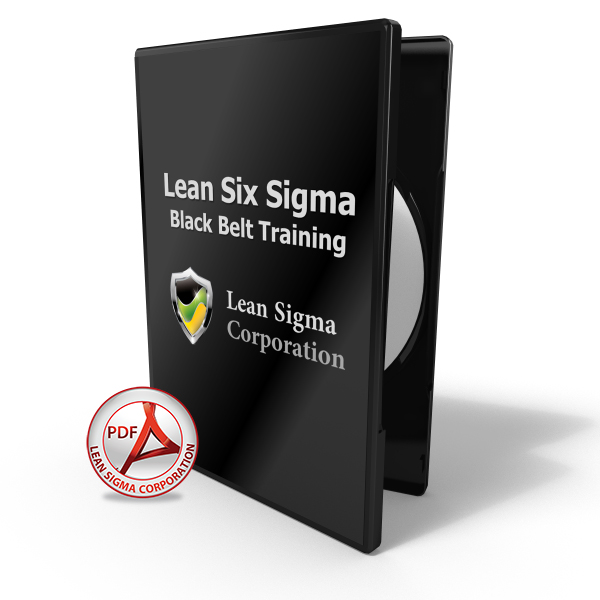
Training Slides
Included!
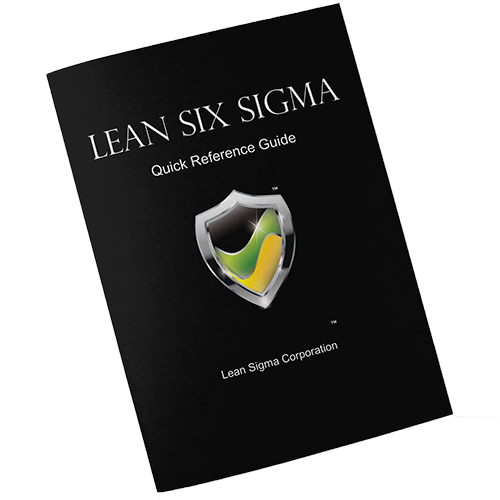
Quick Ref. Guide
Included!

Tools & Templates
Included!

Roadmaps
Included!
How-to Articles | Lifetime Access | Glossary
Lean Six Sigma Transformed My Career

Michael Parker
Founder - Master Black Belt
Like you, I was once an eager and determined professional who looked to make my mark in the corporate world. Twenty years ago, I met a Six Sigma Master Black Belt who insisted upon excellence and held me accountable. He provided me with guidance, expertise, and wisdom for the price of my eagerness and at his insistence, my patience.
His guidance led me down the rewarding path of Six Sigma, where I found something worthy of mastering. Six Sigma, as it turns out, was my true professional development, leading to my maturity, consistent promotions, career growth, and nearly doubling my salary upon certification.
If you have my kind of eagerness and enthusiasm, I have your kind of training and guidance. Together, we can write your story of success!
Customers and Clients








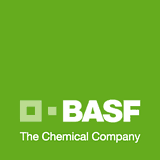










Choose Your Career Transformation Package
50 PDU

Lean Six Sigma Yellow Belt
Designed For: Executive-level decision-makers, managers, or subject matter experts (SMEs) who seek to understand Lean Six Sigma principles without the "Analyze or Improve" phases of the DMAIC methodology. Learn to understand!
Lean Six Sigma Yellow Belt Certification - Course Details
| Course Title | Lessons | Quizzes |
Phase Tests |
Exam Attempts |
Exam Questions |
Pass Score |
Time Limit |
Pass Rate |
Sat. Rating | PDU |
Earned Designation |
Avg. Completion | Price |
|---|---|---|---|---|---|---|---|---|---|---|---|---|---|
| Lean Six Sigma Yellow Belt | 11 | 11 | 3 | 2 | 50 | 80% | 1Hr. | 97.9% | 96.4% | 50 | LSSYB | 27 Days | $595 |

Certification Requirements
- Complete all Lessons and Quizzes
- Pass all Phase Tests (unlimited attempts, passing score 80%)
- Pass the LSSYB Certification Exam (2 attempts, passing score 80%, 1hr. time limit)
- Complete the Required Course Feedback Form
Course Does Not Require a Project | Statistical Software is Not Required | Default Statistical References: Minitab. SigmaXL and JMP Versions are Available on Request | Curriculum Compatibility: Minitab v.22, SigmaXL v.10, JMP v.18. KEY: LSS = Lean Six Sigma | SS = Six Sigma | BB = Black Belt | GB = Green Belt | YB = Yellow Belt | PDU = Professional Development Units
Lean Six Sigma Yellow Belt Course Outline
-
Define Phase
Overview of Six Sigma
Six Sigma Fundamentals
Lean Six Sigma Projects
Lean Fundamentals
Define Phase Test
-
Measure Phase
Process Definition
Six Sigma Statistics
Measurement Systems
Process Capability
Measure Phase Test
-
Analyze PhasePatterns of Variation
Inferential Statistics
Hypothesis Testing
Hyp. Tests Normal
Hyp. Tests Non-Normal
Analyze Phase Test
-
Improve PhaseSimple Linear Regression
Multiple Regression
Design of Experiment
Full Factorial DOE
Fractional Factorial DOE
Improve Phase Test
-
Control Phase
Statistical Process Control
Six Sigma Control Plans
Lean Controls
Control Phase Test
LSSYB Certification Exam
-
DEFINE PHASE
-
Overview of Six Sigma
What is Six Sigma
Six Sigma History
Six Sigma Approach Y = f(x)
Six Sigma Methodology
Roles & Responsibilities -
Six Sigma Fundamentals
Defining a Process
VOC & CTQ's
QFD
Cost of Poor Quality
Pareto Analysis (80:20 rule) -
Lean Six Sigma Projects
Six Sigma Metrics
Rolled Throughput Yield
Business Case & Charter
Project Team Selection
Project Risk Management
Project Planning -
Lean Fundamentals
Lean and Six Sigma
History of Lean
Seven Deadly Muda
Five-S (5S)
Define Phase Test
-
MEASURE PHASE
-
Process Definition
Cause & Effect Diagram
Cause & Effect Matrix
Process Mapping
FMEA
Theory of Constraints -
Six Sigma Statistics
Basic Statistics
Descriptive Statistics
Distributions & Normality
Graphical Analysis -
MSA
Precision & Accuracy
Bias, Linearity & Stability
Gage R&R
Variable & Attribute MSA -
Process Capability
Capability Analysis
Concept of Stability
Attribute vs Discrete
Monitoring Techniques
Measure Phase Test
-
ANALYZE PHASE
-
Patterns of Variation
Multi-Vari Analysis
Classes of Distributions -
Inferential Statistics
Understanding Inference
Sampling Techniques
Sample Size
Central Limit Theorem -
Hypothesis Testing
Hypothesis Testing
Statistical Significance
Risk; Alpha & Beta
Types of Hypothesis Tests -
Hyp. Tests Normal
1-sample t-test
2-Sample t-test
Paired t-test
1-sample variance
One Way ANOVA -
Hyp. Tests Non-Normal
Mann-Whitney
Moods Median
Kruskal-Wallis / Friedman
1 Sample Sign & Wilcoxon
1 & 2 Sample Proportions
Chi-Squared
Test of Equal Variances
Analyze Phase Test
-
IMPROVE PHASE
-
Simple Linear Reg.
Correlation
X-Y Diagram
Regression Equations
Residuals Analysis -
Multiple Regression
Non-Linear Reg.
Multiple Linear Reg.
Confidence Intervals
Residuals Analysis
Box-Cox Transformation
Stepwise Regression
Logistic Regression -
Design of Experiment
Experiment Objectives
Experimental Methods
DOE Design Considerations -
Full Factorial DOE
2k Full Factorial Designs
Linear & Quadratic Models
Orthogonal Designs
Fit, Model & Center Points -
Fractional Factorial DOE
Fractional Designs
Confounding Effects
Experimental Resolution
Improve Phase Test
-
CONTROL PHASE
-
SPC
Data Collection for SPC
Individuals Charts
Xbar Charts
Proportions Charts
CumSum, EWMA Charts
Control Chart Anatomy
Subgroups & Sampling
Control Limits -
Lean Controls
Control Methods for 5S
Kanban
Poka-Yoke -
Six Sigma Control Plans
Cost Benefit Analysis
Control Plan Elements
Response Plan Elements
Control Phase Test -
LSSYB Certification Exam
85 PDU

Lean Six Sigma Green Belt
Designed For: Individual contributors, project managers, analysts, or specialists, seeking to understand and apply Lean Six Sigma principles, utilizing the comprehensive DMAIC methodology to design improve business results.
Lean Six Sigma Green Belt Certification - Course Details
| Course Title | Lessons | Quizzes |
Phase Tests |
Exam Attempts |
Exam Questions |
Pass Score |
Time Limit |
Pass Rate |
Sat. Rating | PDU |
Earned Designation |
Avg. Completion | Price |
|---|---|---|---|---|---|---|---|---|---|---|---|---|---|
| Lean Six Sigma Green Belt | 17 | 17 | 5 | 2 | 100 | 80% | 2Hrs. | 94.2% | 94.5% | 85 | LSSGB | 51 Days | $795 |

Certification Requirements
- Complete all Lessons and Quizzes
- Pass all Phase Tests (unlimited attempts, passing score 80%)
- Pass the LSSGB Certification Exam (2 attempts, passing score 80%, 2hr. time limit)
- Complete the Required Course Feedback Form
Course Does Not Require a Project | Statistical Software is Not Required | Default Statistical References: Minitab. SigmaXL and JMP Versions are Available on Request | Curriculum Compatibility: Minitab v.22, SigmaXL v.10, JMP v.18. KEY: LSS = Lean Six Sigma | SS = Six Sigma | BB = Black Belt | GB = Green Belt | YB = Yellow Belt | PDU = Professional Development Units
Lean Six Sigma Green Belt Course Outline
-
Define Phase
Overview of Six Sigma
Six Sigma Fundamentals
Lean Six Sigma Projects
Lean Fundamentals
Define Phase Test
-
Measure Phase
Process Definition
Six Sigma Statistics
Measurement Systems
Process Capability
Measure Phase Test
-
Analyze Phase
Patterns of Variation
Inferential Statistics
Hypothesis Testing
Hyp. Tests Normal
Hyp. Tests Non-Normal
Analyze Phase Test
-
Improve Phase
Simple Linear Regression
Multiple Regression
Design of Experiment
Full Factorial DOE
Fractional Factorial DOE
Improve Phase Test
-
Control Phase
Statistical Process Control
Six Sigma Control Plans
Lean Controls
Control Phase Test
LSSGB Certification Exam
-
DEFINE PHASE
-
Overview of Six Sigma
What is Six Sigma
Six Sigma History
Six Sigma Approach Y = f(x)
Six Sigma Methodology
Roles & Responsibilities -
Six Sigma Fundamentals
Defining a Process
VOC & CTQ's
QFD
Cost of Poor Quality
Pareto Analysis (80:20 rule) -
Lean Six Sigma Projects
Six Sigma Metrics
Rolled Throughput Yield
Business Case & Charter
Project Team Selection
Project Risk Management
Project Planning -
Lean Fundamentals
Lean and Six Sigma
History of Lean
Seven Deadly Muda
Five-S (5S)
Define Phase Test
-
MEASURE PHASE
-
Process Definition
Cause & Effect Diagram
Cause & Effect Matrix
Process Mapping
FMEA
Theory of Constraints -
Six Sigma Statistics
Basic Statistics
Descriptive Statistics
Distributions & Normality
Graphical Analysis -
MSA
Precision & Accuracy
Bias, Linearity & Stability
Gage R&R
Variable & Attribute MSA -
Process Capability
Capability Analysis
Concept of Stability
Attribute vs Discrete
Monitoring Techniques
Measure Phase Test
-
ANALYZE PHASE
-
Patterns of VariationMulti-Vari Analysis
Classes of Distributions -
Inferential Statistics
Understanding Inference
Sampling Techniques
Sample Size
Central Limit Theorem -
Hypothesis Testing
Hypothesis Testing
Statistical Significance
Risk; Alpha & Beta
Types of Hypothesis Tests -
Hyp. Tests Normal
1-sample t-test
2-Sample t-test
Paired t-test
1-sample variance
One Way ANOVA -
Hyp. Tests Non-Normal
Mann-Whitney
Moods Median
Kruskal-Wallis / Friedman
1 Sample Sign & Wilcoxon
1 & 2 Sample Proportions
Chi-Squared
Test of Equal Variances
Analyze Phase Test
-
IMPROVE PHASE
-
Simple Linear Reg.
Correlation
X-Y Diagram
Regression Equations
Residuals Analysis -
Multiple Regression
Non-Linear Reg.
Multiple Linear Reg.
Confidence Intervals
Residuals Analysis
Box-Cox Transformation
Stepwise Regression
Logistic Regression -
Design of ExperimentExperiment Objectives
Experimental Methods
DOE Design Considerations -
Full Factorial DOE2k Full Factorial Designs
Linear & Quadratic Models
Orthogonal Designs
Fit, Model & Center Points -
Fractional Factorial DOEFractional Designs
Confounding Effects
Experimental Resolution
Improve Phase Test
-
CONTROL PHASE
-
SPC
Data Collection for SPC
Individuals Charts
Xbar Charts
Proportions Charts
CumSum, EWMA Charts
Control Chart Anatomy
Subgroups & Sampling
Control Limits -
Lean Controls
Control Methods for 5S
Kanban
Poka-Yoke -
Six Sigma Control Plans
Cost Benefit Analysis
Control Plan Elements
Response Plan Elements
Control Phase Test -
LSSGB Certification Exam
105 PDU

Lean Six Sigma Black Belt
Designed For: High performers who wish to be leaders and seek advanced problem-solving skills with the ability to train others in Lean Six Sigma concepts and principles. Black Belts are facilitators, mentors, and instructors.
Lean Six Sigma Black Belt Certification - Course Details
| Course Title | Lessons | Quizzes |
Phase Tests |
Exam Attempts |
Exam Questions |
Pass Score |
Time Limit |
Pass Rate |
Sat. Rating | PDU |
Earned Designation |
Avg. Completion | Price |
|---|---|---|---|---|---|---|---|---|---|---|---|---|---|
| Lean Six Sigma Black Belt | 21 | 21 | 5 | 2 | 150 | 80% | 3Hrs. | 92.6% | 96.3% | 105 | LSSBB | 54 Days | $995 |

Certification Requirements
- Complete all Lessons and Quizzes
- Pass all Phase Tests (unlimited attempts, passing score 80%)
- Pass the LSSBB Certification Exam (2 attempts, passing score 80%, 3hr. time limit)
- Complete the Required Course Feedback Form
Course Does Not Require a Project | Statistical Software is Not Required | Default Statistical References: Minitab. SigmaXL and JMP Versions are Available on Request | Curriculum Compatibility: Minitab v.22, SigmaXL v.10, JMP v.18. KEY: LSS = Lean Six Sigma | SS = Six Sigma | BB = Black Belt | GB = Green Belt | YB = Yellow Belt | PDU = Professional Development Units
Lean Six Sigma Black Belt Course Outline
-
Define Phase
Overview of Six Sigma
Six Sigma Fundamentals
Lean Six Sigma Projects
Lean Fundamentals
Define Phase Test
-
Measure Phase
Process Definition
Six Sigma Statistics
Measurement Systems
Process Capability
Measure Phase Test
-
Analyze Phase
Patterns of Variation
Inferential Statistics
Hypothesis Testing
Hyp. Tests Normal
Hyp. Tests Non-Normal
Analyze Phase Test
-
Improve Phase
Simple Linear Regression
Multiple Regression
Design of Experiment
Full Factorial DOE
Fractional Factorial DOE
Improve Phase Test
-
Control Phase
Statistical Process Control
Six Sigma Control Plans
Lean Controls
Control Phase Test
LSSBB Certification Exam
-
DEFINE PHASE
-
Overview of Six Sigma
What is Six Sigma
Six Sigma History
Six Sigma Approach Y = f(x)
Six Sigma Methodology
Roles & Responsibilities -
Six Sigma Fundamentals
Defining a Process
VOC & CTQ's
QFD
Cost of Poor Quality
Pareto Analysis (80:20 rule) -
Lean Six Sigma Projects
Six Sigma Metrics
Rolled Throughput Yield
Business Case & Charter
Project Team Selection
Project Risk Management
Project Planning -
Lean Fundamentals
Lean and Six Sigma
History of Lean
Seven Deadly Muda
Five-S (5S)
Define Phase Test
-
MEASURE PHASE
-
Process Definition
Cause & Effect Diagram
Cause & Effect Matrix
Process Mapping
FMEA
Theory of Constraints -
Six Sigma Statistics
Basic Statistics
Descriptive Statistics
Distributions & Normality
Graphical Analysis -
MSA
Precision & Accuracy
Bias, Linearity & Stability
Gage R&R
Variable & Attribute MSA -
Process Capability
Capability Analysis
Concept of Stability
Attribute vs Discrete
Monitoring Techniques
Measure Phase Test
-
ANALYZE PHASE
-
Patterns of Variation
Multi-Vari Analysis
Classes of Distributions -
Inferential Statistics
Understanding Inference
Sampling Techniques
Sample Size
Central Limit Theorem -
Hypothesis Testing
Hypothesis Testing
Statistical Significance
Risk; Alpha & Beta
Types of Hypothesis Tests -
Hyp. Tests Normal
1-sample t-test
2-Sample t-test
Paired t-test
1-sample variance
One Way ANOVA -
Hyp. Tests Non-Normal
Mann-Whitney
Moods Median
Kruskal-Wallis / Friedman
1 Sample Sign & Wilcoxon
1 & 2 Sample Proportions
Chi-Squared
Test of Equal Variances
Analyze Phase Test
-
IMPROVE PHASE
-
Simple Linear Reg.
Correlation
X-Y Diagram
Regression Equations
Residuals Analysis -
Multiple Regression
Non-Linear Reg.
Multiple Linear Reg.
Confidence Intervals
Residuals Analysis
Box-Cox Transformation
Stepwise Regression
Logistic Regression -
Design of Experiment
Experiment Objectives
Experimental Methods
DOE Design Considerations -
Full Factorial DOE
2k Full Factorial Designs
Linear & Quadratic Models
Orthogonal Designs
Fit, Model & Center Points -
Fractional Factorial DOE
Fractional Designs
Confounding Effects
Experimental Resolution
Improve Phase Test
-
CONTROL PHASE
-
SPC
Data Collection for SPC
Individuals Charts
Xbar Charts
Proportions Charts
CumSum, EWMA Charts
Control Chart Anatomy
Subgroups & Sampling
Control Limits -
Lean Controls
Control Methods for 5S
Kanban
Poka-Yoke -
Six Sigma Control Plans
Cost Benefit Analysis
Control Plan Elements
Response Plan Elements
Control Phase Test -
LSSBB Certification Exam
When You're Lean Six Sigma Certified!
Certification Directory Listing
Entry into our Official Certification Directory showcases your achievements to the world.
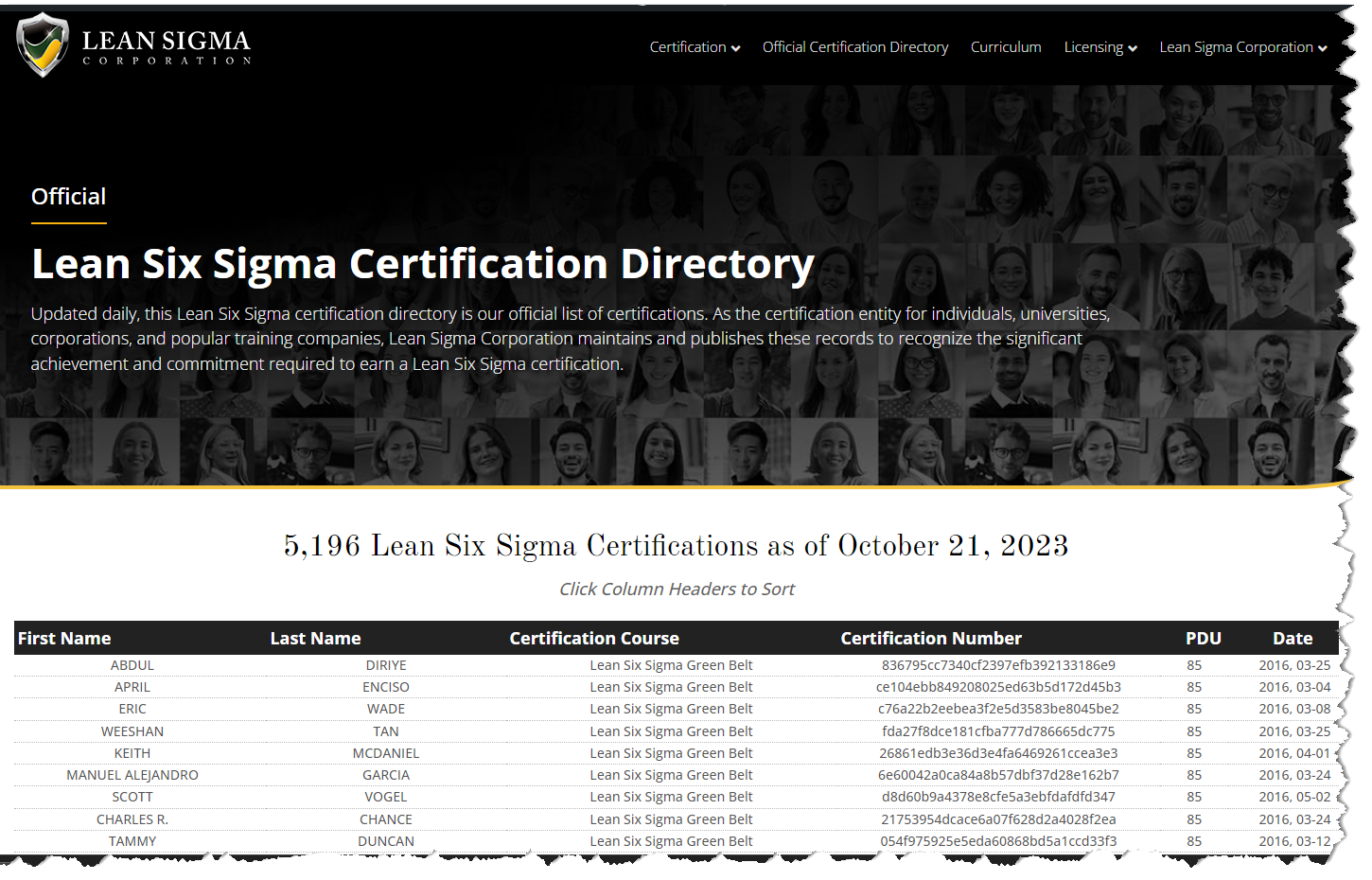
Custom Digital Certificate
A symbol of your professional expertise and achievement.
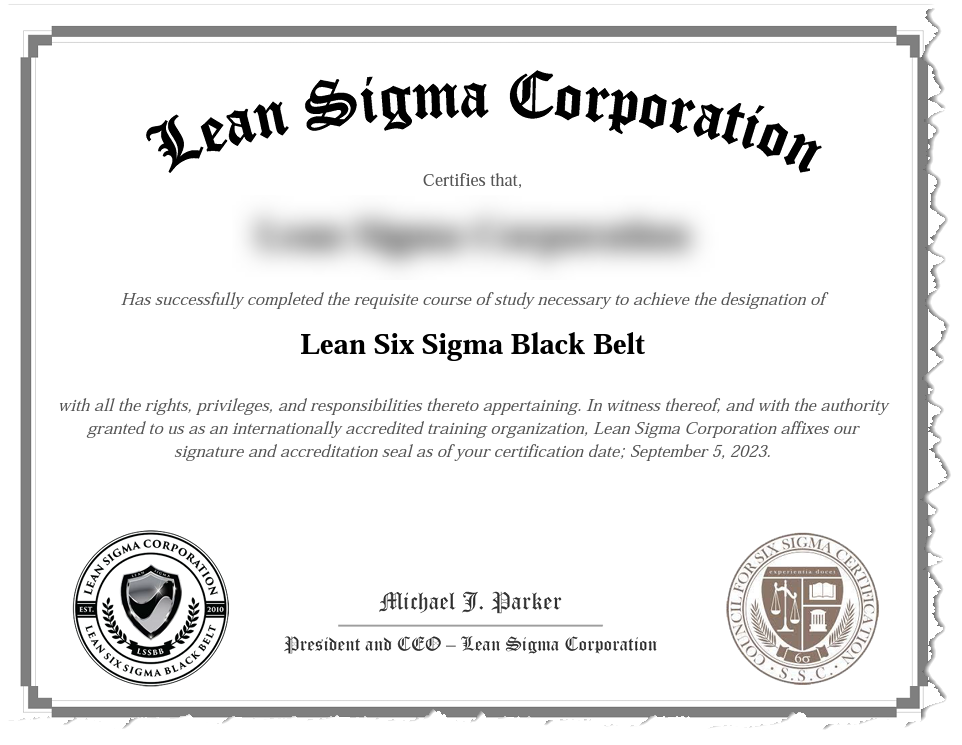
Satisfied and Already Certified!

"I took Six Sigma many years ago while at Hewlett Packard, and this training has given me the needed skills to look for project management roles to grow my career."
Anthony Anderson

"Fantastic course organized in a very efficient and easy-to-learn manner. The reference materials provided were also excellent, and knowing that I will have access to them in the future is a huge bonus. I would highly recommend this course."
Michael Weigele
Frequently Asked Questions
All of our courses provide Professional Development Units referred to as PDUs. One PDU is equivalent to 1 contact hour of professional development. Our course offerings and their PDU's are list below:
Two
All of our courses and Exams allow for two certification exam attempts.
The passing score is 80%
- Yellow Belt - Understand Six Sigma
- For Decision-Makers and Contributors Seeking to Understand the Principals of Six Sigma without the Analysis or Improvement Phases of DMAIC. Methodology
- Green Belt - Apply Six Sigma
- For Specialists Seeking to Understand and Apply Six Sigma principles utilizing the Comprehensive D.M.A.I.C. Methodology to Design Better Processes and Improve Results
- Black Belt - Lead with Six Sigma
- For Process Leaders Seeking Advanced problem-solving skills and the Ability to Apply Six Sigma principles and DMAIC Methodology to Solve Complex Challenges and Drive Efficiency and Excellence
- Black Belts also teach, coach, and mentor Green Belts
The top three differences between Six Sigma and Lean Six Sigma are:
Content - Lessons added to Six Sigma to get Lean Six Sigma
- Lean Fundamentals
- Lean and Six Sigma
- History of Lean
- Seven Deadly Muda
- Five-S (5S)
- Lean Controls
- Control Methods for 5S
- Kanban
- Poke-Yoke
Earned Designation
- Lean Six Sigma Black Belt: LSSBB
- Lean Six Sigma Green Belt: LSSGB
- Lean Six Sigma Yellow Belt: LSSYB
- Six Sigma Black Belt: SSBB
- Six Sigma Green Belt: SSGB
- Six Sigma Yellow Belt: SSYB
Price
- Lean Six Sigma Black Belt $995
- Lean Six Sigma Green Belt $795
- Lean Six Sigma Yellow Belt $595
- Six Sigma Black Belt $795
- Six Sigma Green Belt $595
- Six Sigma Yellow Belt $395
No, there are no prerequisites for Yellow Belt, Green Belt, or Black Belt certification. There is, however, a prerequisite for Master Black Belt certification, which is Black Belt certification.
No, there are no educational or industry prerequisites for Yellow Belt, Green Belt, or Black Belt.
Yes. We offer stand-alone Six Sigma and Lean Six Sigma certification exams.
No. Our content and courses do reference statistical software, but the courses can be completed successfully without software.
The default statistical software referenced in our courses is Minitab. Courses referencing SigmaXL and JMP are available on request.
All software providers offer a free trial. You can (encouraged) download a free trial and follow closely along in our training to gain valuable new knowledge and analytical skills.
All of our courses provide two certification exam attempts.
If you do not pass on the second attempt, you may purchase a test reset, giving you two more attempts. Test resets can be found on your account page: https://leansigmacorporation.com/account
No, statistical software is not necessary for our certification exams.

